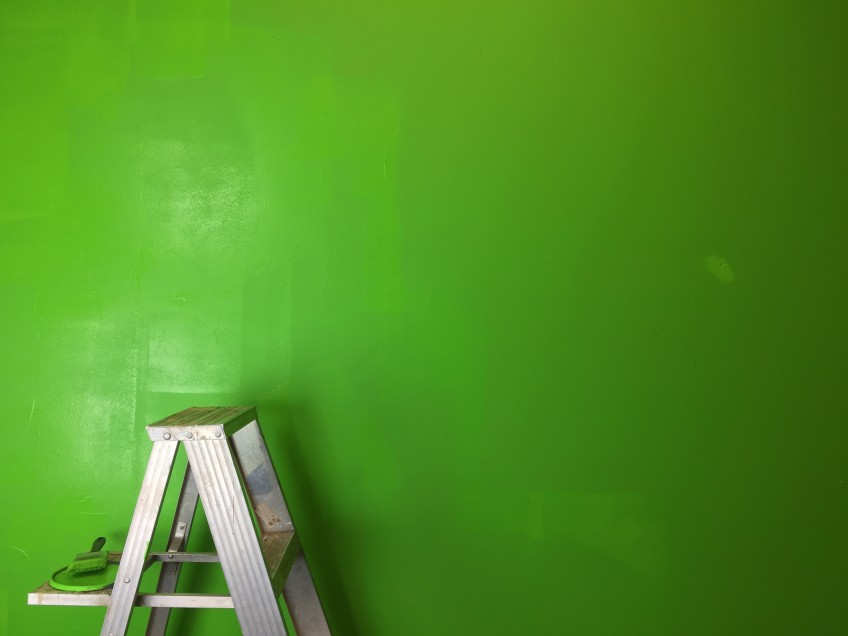Introduction
Fiberglass, aluminum, wood. Extension ladders, step ladders, multi-purpose ladders. When you consider all the options and combinations, choosing a ladder isn't a simple task! Read on to learn the basics and make your choice easier.
Step by step
Ladder Materials
Let's start by talking about ladder materials, since all ladder types can come in pretty much any one of these materials.
- Wood
Wood is affordable and won't conduct electricity when dry. It used to be seen in all types of ladders (including extension), but now is most common for lighter duty uses like smaller step ladders and step stools. Part of this is because wood is not the lightest material, so larger ladders become difficult to manage, but also because wood is best suited for indoor applications. When wood gets wood, it tends to warp and swell, eventually leading to weakening and splintering. - Metal (Aluminum & Steel)
Aluminum is a low cost option that is the lightest of all types and more durable than wood or fiberglass. Steel is heavier and typically not found in portable ladders used in homes. The biggest disadvantage of metal is its ability to conduct electricity, which is a concern when working on or near electricity from the ladder. For many homeowners who primarily complete simple tasks like painting, hanging pictures, etc., this isn't a concern. However, if you regularly tackle electrical jobs, consider investing in a fiberglass ladder instead.
If you are looking for a long extension ladder (20'+), ladder is your only logical choice as either wood or fiberglass will be too heavy to manage. If you have a two story home and will use an extension ladder like this on a regular basis, it is worth the investment. - Fiberglass
Fiberglass is the widely considered the best material of all. It has many of the same advantages as wood (non-conductive), nearly as lightweight as metal, and impervious to water. Unfortunately these advantages come at a cost, as a quality fiberglass ladder is not a small investment.
Perhaps the one disadvantage of fiberglass is its tendency to "shed" fiberglass splinters over time. This can largely be avoided by storing the ladder outside of direct sunlight and periodically applying a spray lacquer coating to the exterior.
Ladder Types
Now that we've covered the three main ladder materials, let's talk about ladder types.
- Step Stools
A step stool may not technical be a ladder, but it is still handy to have around! These are typically just a few feet high and only have 2-3 steps. They are usually designed in a way that allows you to step on the top platform safety, which is a big no-no on real ladders.
Keeping a step stool in the house is important, as it will keep you from standing on furniture or other items to do common tasks like change a smoke alarm battery, swap an air filter, or clean on top of a cabinet. We recommend something like this Rubbermaid model. - Step Ladders
Step ladders are designed to fold up for storage and spread out in an A-shape when in use. They utilize spreader bars to keep them in place and are self supported, meaning they don't need to be leaned against a wall to be used.
Step ladders commonly come in 6', 8', 10' and 12' heights. Anything shorter is more of a step stool application and anything bigger is a job for an extension ladder (or maybe a trestle ladder, if you're brave enough!). Step ladders come in all material types, but we recommend a good quality fiberglass ladder for most applications.
For height, consider your most common tasks and the ceiling heights within your home. Remember that you never stand on the second to top step, or the top platform, on a ladder, so you can deduct about 2' from the height of a ladder to get the actual platform height. Add in your height and arm reach and you'll have a good idea of how high you can reach. A standard 6' ladder should be good for tasks that are 8-10' up, depending on your height.
Keep in mind that bigger isn't always better. You'll have to be careful not to scuff up your ceilings if your ceiling is 8' and you have a 8' ladder! Having said that, don't try to get up on your 12' ceiling with a 6' ladder. There's no way to do it safely, so buy what is best for the majority of your needs and rent, borrow, or hire out the occassional tasks. - Extension Ladders
If you plan to get on your roof, you need an extension ladder. You may think you can get away with your 10-12' step ladder if you have a older ranch style home, but remember that you need to have a proper angle and 3' of ladder extending beyond the roofline in order to safety climb and dismount a ladder. Below is a ladder angle guide from OSHA that shows the proper angle formula you need when using an extension ladder.
Image Source: OSHA
Using this formula, if you have a roofline that is 20' from the ground (vertical distance), the ladder should be about 28' long. Here's a full chart with a guide on extension ladder lengths from Werner Ladders.
Image Source: Werner
Extension ladders are more complex than step ladders as they have a rope and pulley mechanism designed to the lift the "fly" section and extend the height beyond the "base" length. This allows extension ladders to extend to nearly twice their compacted length. The complexity and increased heights means quality is that much more important when selecting an extension ladder.
Due to the length of extension ladders, you should primarily consider aluminum rather than wood or fiberglass. This will make moving and setting up the ladder much easier. Here's a good aluminum extension ladder option, but select the length that will be best for you based on the chart above. - Multi-Purpose Ladders
Multi-purpose ladders are a relatively more recent development and seek to fulfill the needs of homeowners looking for an straight ladder, step ladder, and even stair ladder (multi-levels) in one package. Perhaps the most common brand is Little Giant, so often times all ladders are referred to by this name.
As you can see from the above image, multi-purpose ladders are a little different than the first few we looked at. They are designed to be set up in a A-shape (step ladder) format, as well as extended straight out. They typically don't extend, but if you get one long enough (see the chart above under the extension ladder section), you will likely be able to take care of anything at a single story house with one of these.
Some multi-purpose ladders go one step further and have multiple pivot points, to allow for setup on stairs or use as scaffolding. While functional, these do tend to have more moving parts and potential failure points, so be aware that they are typically for light use when considering a purchase.
Duty Ratings
Now that we've covered all ladder materials and types, let's talk about Duty Ratings. All ladders should have a label with the assigned Duty Rating noted. this indicates the weight that the ladder can support.
| Type IAA (Extra Heavy Duty) | 375 pounds |
| Type IA (Extra Heavy Duty) | 300 pounds |
| Type I (Heavy Duty) | 250 pounds |
| Type II (Medium Duty) | 225 pounds |
| Type III (Light Duty) | 200 pounds |
Source: American Ladder Institute
Keep in mind that you need to add in the weight of any tools or materials you'll have on the ladder in addition to your own weight when considering the proper duty rating.
Summary
Ladders are an essential tool for every homeowner to have. Investing in the ones that are right for your situation and of good quality is important to your safety. Don't skimp when buying your ladders and be sure to inspect your ladders annually as well!




